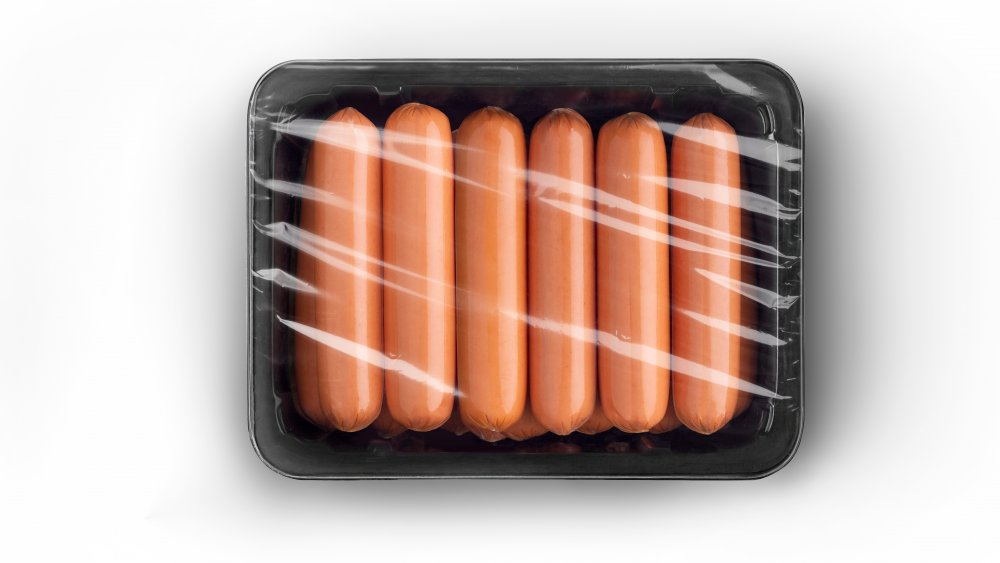The Ingredient You'd Be Surprised Is In The Hot Dog You're Eating
Perhaps the question has crossed our mind before — what's actually in this hot dog? — but we always manage to drown it out with mustard and relish. Can't we just enjoy this one, simple pleasure? Admit it. You're here because deep down, a dark, twisted part of you wants to know.
Look, there was a reason Upton Sinclair penned The Jungle over a century ago. The meat industry was rife with unsanitary conditions. Sinclair's reports were so repulsive that they led to federal regulation of America's food industry, according to The New York Times. Still, there's enough room within the law for bizarre ingredients.
If we were to take the words of the National Hot Dog and Sausage Council at face value, the making of a hot dog seems like a wholesome, almost whimsical process, as though a loving grandmother is tucked away somewhere, painstakingly preparing each and every frank. "First, specially selected meat trimmings of beef and/or pork — just like the meat you buy in your grocer's case — are cut or ground into small pieces and placed in a mixer."
That sounds nice — artisanal, almost — until we do a deep dive into what a "trimming" entails. According to Gizmodo, a trimming can be many things, including "head meat, animal feet, animal skin, blood, liver and other edible slaughter by-products." Luckily, these substances are cooked before they're pumped into the hot dog paste, eliminating any possibility of bacteria.
Other unsavory hot dog ingredients
If the hot dog you're buying is organic, you might be in the clear. Organic meat must come from animals that haven't consumed antibiotics or growth hormones, according to the Environmental Working Group. But your regular, everyday hot dog has a much more complicated past. For decades, farms have been feeding antibiotics to livestock. The effect? They become resistant to disease. They also grow faster, become fatter, and bring in more profit (via Nourished Kitchen).
Now, what does this mean? Are we consuming unfamiliar medicines every time we bite into a hot dog? The answer is: technically, no. Federal law requires that animal products be vetted for any sort of contamination. And, before animals are slaughtered, farmers are supposed to confirm that all drugs have left their system. However, the overconsumption of antibiotics can lead to resistant bacteria, so nothing is completely risk-free (via Healthline).
A controversial chemical could be in your hot dog
Hot dogs also contain sodium nitrite. This inorganic chemical helps to cure meat — it's used in hot dogs, bacon, and salami. It allows the hot dog to keep its color, which, when we think about it, is a little too colorful to be natural. But sodium nitrite has caused speculation for certain health risks. It can, in some circumstances, like when the meat is cooked at a very high temperature, create a higher risk for cancer. That doesn't mean processed meats are carcinogenic, though. Kate Allen, an executive director at the World Cancer Research Fund, explains it's "the way they are cooked and their local environment that is an important factor" (via BBC).
You can actually opt out of consuming sodium nitrite in your hot dogs. Some brands have even incorporated celery powder or celery juice— if you're picking up organic or uncured hot dogs, it's a common ingredient (via The Chicago Tribune). It's often used to replace the somewhat-controversial ingredient. But, even celery powder is controversial due to its naturally-occurring nitrate content (via Meat Myth Crushers).
Sheep, cellulose, and collagen (oh my)
How does the hot dog retain that perfect shape? Most sausages and franks have been made using some sort of elastic casing; some brands refer to it as natural casing, because that sounds a lot nicer than "sheep intestines" (via HuffPost).
The National Hot Dog and Sausage Council confirms this, too, noting in its ingredient guide that pig and sheep intestines are cleaned and often used as natural casing. Key word: cleaned. According to the council, it's totally worth it: "Natural casing hot dogs have the characteristic snap when you bite into them."
Of course, it is 2020, and there are alternatives. Collagen casings are made from beef proteins, and cellulose casings are sometimes used to smoke the hot dog before the plant-based casings are discarded. So paying more attention to the labels can teach you a lot— then again, at the end of the day, you're still eating a hot dog.



